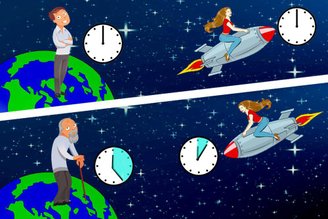Consider this situation: There are two twin siblings who were born at the same time and are almost identical. One of the adults decides to go on a space voyage, whose ship can reach speeds close to the speed of light, while the other remains on Earth.
When the astronaut twin returned, a strange thing happened: He is noticeably younger than his remaining brother.
This scenario explains The well-known twins paradox, which at first glance challenges our intuition about time. How is it possible for two people born at the same time to have different ages?
To answer this question, we need to go back to the roots of the paradox, to the Special Theory of Relativity developed by Albert Einstein in 1905. According to this theory, time and space are not absolute; instead they depend on the speed at which the observer is moving.
This idea implies a phenomenon known as time dilation, which translates into the following fact: The faster someone moves relative to an observer, the slower time flows for that person.
In the case of the twin paradox, the sibling who travels into space at close to the speed of light experiences time differently than the sibling who remains on Earth. For the astronaut, the journey may last only a few years, but for the stay-at-home sibling, much more time may have passed.
“This effect is time dilation in action.
The reason why the term “paradox” is used here is that this phenomenon seems contradictory at first glance. According to Special Relativity, each twin can say that time flows slower for the other because, from each twin’s perspective, the other is in motion. This is the principle of relativity: There is no absolute reference point. But when the astronaut brother returns, the age difference becomes clear, and only one of the twins has aged more.

The apparent paradox arises because Special Relativity is applied to situations where observers are in uniform linear motion, that is, without accelerating or changing direction. But in the twin paradox, the traveling sibling must accelerate, slow down, change direction, and then accelerate again to return to Earth.
The solution to the paradox then lies in understanding that the twin remaining on Earth remains in an inertial frame of reference (without significant acceleration), while the traveling twin experiences a non-inertial frame of reference due to changes in the Earth’s orbit. in direction and speed.

During these acceleration phases, General Relativity takes effect and the time the astronaut twin lives is “shortened” compared to the time his brother lives on Earth. This effect explains why the twin who remained on Earth at the end of the journey was older..
Simply put, the twin on Earth experienced time in a continuous and fixed way, while the traveling twin experienced time in an expanded way during the trip, especially at the point of highest speed. And it is precisely during these acceleration phases—the point at which the twin must slow down, turn back, and accelerate again—that the asymmetry between the twins emerges and resolves the paradox.
Although we cannot easily send twins on interplanetary journeys at high speeds, the effect of time dilation has been demonstrated in various experimental situations. A famous example is experiments with synchronized atomic clocks.
When a watch is taken in an airplane moving at high speed and then compared to a watch that remains on the ground, it turns out that the traveling watch experiences time more slowly, confirming the prediction of time dilation.

Another test is made by observing subatomic particles such as muons, which have an extremely short lifetime. As they approach the speed of light, their lifespans appear to extend because time passes more slowly in their frame of reference.. This time dilation is the same experience that the traveling twin would experience.
The twin paradox is one of many examples of how Einstein’s Theory of Relativity has changed our understanding of the Universe. It teaches us that time and space are not fixed but change with motion and gravity. Although it may seem contradictory at first glance, the effect of time dilation is a fact confirmed by modern physics.
This seemingly simple conundrum reveals how much we still have to learn about how the universe works and challenges our intuitive view that time is the same for everyone.
Source: Tec Mundo
I’m Blaine Morgan, an experienced journalist and writer with over 8 years of experience in the tech industry. My expertise lies in writing about technology news and trends, covering everything from cutting-edge gadgets to emerging software developments. I’ve written for several leading publications including Gadget Onus where I am an author.













